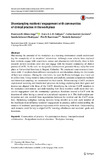Mostrar el registro sencillo del registro
Disentangling residents' engagement with communities of clinical practice in the workplace
| dc.rights.licence | Atribución-NoComercial 4.0 Internacional | * |
| dc.contributor.author | Olmos Vega, Francisco M. | |
| dc.contributor.author | Dolmans, Diana H J M | |
| dc.contributor.author | Guzmán Quintero, Carlos | |
| dc.contributor.author | Echeverri Rodriguez, Camila | |
| dc.contributor.author | Teunnissen, Pim W. | |
| dc.contributor.author | Stalmeijer, Renée E. | |
| dc.coverage.spatial | Colombia | spa |
| dc.date.accessioned | 2020-05-28T23:35:46Z | |
| dc.date.available | 2020-05-28T23:35:46Z | |
| dc.date.created | 2019-01-18 | |
| dc.identifier | https://link.springer.com/article/10.1007%2Fs10459-019-09874-9 | spa |
| dc.identifier.issn | 1382-4996 / 1573-1677 (Electrónico) | spa |
| dc.identifier.uri | http://hdl.handle.net/10554/49501 | |
| dc.format | spa | |
| dc.format.mimetype | application/pdf | spa |
| dc.language | spa | spa |
| dc.rights.uri | http://creativecommons.org/licenses/by-nc/4.0/ | * |
| dc.source | Advances in health sciences education; Vol. 24 Núm. 3 (2019) | spa |
| dc.title | Disentangling residents' engagement with communities of clinical practice in the workplace | spa |
| dc.type | info:eu-repo/semantics/article | |
| dc.type.hasversion | http://purl.org/coar/version/c_ab4af688f83e57aa | |
| dc.description.quartilewos | Q2 | spa |
| dc.description.quartilescopus | Q1 | spa |
| dc.coverage.city | Bogotá (Colombia) | |
| dc.identifier.doi | https://doi.org/10.1007/s10459-019-09874-9 | spa |
| dc.description.paginas | 459-475 | spa |
| dc.format.soporte | Papel / Electrónico | spa |
| dc.subject.keyword | Co-participation theory | spa |
| dc.subject.keyword | Communities of practice | spa |
| dc.subject.keyword | Interprofessional collaboration | spa |
| dc.subject.keyword | Postgraduate medical education | spa |
| dc.description.abstractenglish | Maximising the potential of the workplace as a learning environment entails understanding the complexity of its members’ interactions. Although some articles have explored how residents engage with supervisors, nurses and pharmacists individually, there is little research on how residents enter into and engage with the broader community of clinical practice (CoCP). To this end, we designed a constructivist grounded theory study that took place at Universidad Javeriana in Bogotá, Colombia. We conducted semi-structured interviews with 13 residents from different training levels and disciplines during the first weeks of their new rotations. During the interviews, we used the Pictor technique as a visual aid to collect data. Using iterative data collection and analysis, constant comparison methods and theoretical sampling, we constructed the final results. When entering a CoCP, residents experienced recurring and intertwined processes including: exploring how their goals and interest are aligned with those of the CoCP; identifying the relevant CoCP members in the workplace environment; and understanding how these members could assist their successful engagement with the community’s practices. Residents entered a CoCP with the intention of either having a central or a peripheral trajectory in it. The final resident participation and role resulted from negotiations between the resident and the CoCP members. Optimising workplace learning includes being mindful as to how each member of the healthcare team influence residents’ engagement on practice, and on understanding the nuances of residents’ participatory trajectories while interacting with them. Understanding such nuances could be key to align CoCPs’ learning affordances and residents’ goals and intentions. | spa |
| dc.type.local | Artículo de revista | spa |
| dc.contributor.corporatename | Pontificia Universidad Javeriana. Facultad de Medicina. Departamento de Cirugía y Especialidades. Grupo de Investigación de Cirugía y Especialidades | |
| dc.contributor.corporatename | Pontificia Universidad Javeriana. Facultad de Medicina. Departamento de Anestesiología | |
| dc.description.orcid | https://orcid.org/0000-0003-1629-4309 | |
| dc.contributor.javerianateacher | Olmos Vega, Francisco M. |


